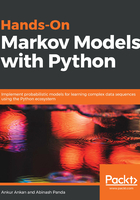
Random variables
As we always do in statistics, let's start with a simple example of rolling a dice. If we consider rolling a fair dice, the outcome of the dice can be anything from 1 to 6, and is random. To represent such situations (the outcome of rolling the dice in this case), in mathematics we use the concept of random variables. We come across a lot of such variables in our everyday lives. Another example could be ordering food at a restaurant. In this case, the outcome could be any food item on the menu. In general terms, a random variable is a variable whose possible values are outcomes of a random phenomenon. The possible states of the outcomes are also known as the domain of the random variable, and the outcome is based on the probability distribution defined over the domain of the random variable.
Coming back to rolling the dice, the domain of the random variable outcome, O, is given by domain(O) = (1, 2, 3, 4, 5, 6), and the probability distribution is given by a uniform distribution P(o) = 1/6 ? ∈ domain(O). Similarly, in the case of the restaurant example, for the random variable choosing a dish, the domain would be every item on the menu, and the probability distribution would depend on your food preference. In both of the previous examples, the domain of the random variable has discrete variables; such random variables are known as discrete random variables. But it's also possible for the domain to be a continuous space. For example, consider the random variable representing the stock price of Google tomorrow. The domain of this random variable will be all positive real numbers with most of the probability mass distributed around ±5% of today's price. Such random variables are known as continuous random variables.